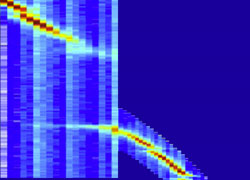Scientists have developed a new method for the real-time detection of individual neutral atoms moving freely, whose sensitivity and accuracy, reaching up to 99.7%, allow the detection of a single atom in less than a millionth of a second, twenty times faster than the best previous methods

Scientists have developed a new method for the real-time detection of individual neutral atoms moving freely, whose sensitivity and accuracy, reaching up to 99.7%, allow the detection of a single atom in less than a millionth of a second, twenty times faster than the best previous methods.
The system, described on the website of the scientific journal Nature Physics, by researchers from the JQI Institute in the state of Maryland, USA and a university in Chile (Universidad de Concepción), uses innovative means to change the polarization of a laser beam trapped between two highly reflective mirrors and thus allows scientists to "see" atoms passing through it using the unique photons they scatter.
The ability to discover particles and individual atoms is essential for the advancement of many fields, including quantum information, chemical discovery and biochemical diagnosis.
"Existing systems are too slow to detect moving individual atoms, and because of this there is absolutely no possibility of influencing them before they disappear. Our work frees researchers from time constraints," says co-author David Norris. "Furthermore, it is difficult to distinguish between a true discovery of an atom and a random false positive without collecting information over a long period of time. Our system both filters the signals and reduces the detection time."
The scientists trapped and cooled a small collection of atoms (in the above case - rubidium atoms) inside an empty container so that they move down slowly, one by one, through a hole that is one and a half millimeters in diameter, to the bottom of a trapping container. [See Figure 1]. The atoms then continue to move down about eight centimeters until they enter a small cell, or cavity, equipped on both sides with high-transparency mirrors facing each other at a distance of 2 millimeters. Through the center of the two mirrors passes a laser beam with a wavelength of 780 nanometers - slightly higher than a visible red light beam. The beam excites the atom falling between the two mirrors and causes it to emit photon radiation in all directions.
Although the array is familiar in research laboratories examining the interrelationships between atoms and photons, the state-of-the-art system, on the other hand, has two unique original characteristics.
First, the researchers use two polarizations of the beam passing through space: one (horizontal) that is induced inside for efficient excitation of the atoms and the other (vertical) that appears only when it is emitted from an atom in space. [See Figure 2].
Although the "fall" of the atom through the tank takes only five millionths of a second, this time is two hundred times longer than the time required for the atoms to be energetically excited and emit photons, so this process can occur many times before the atom finishes its journey in the tank.
Second, the researchers created a magnetic field within the cavity, which causes the polarized laser beam to be slightly deflected when present in an airtight container. This phenomenon, known as the "Faraday effect", is typically extremely weak for a single atom. However, since the beam reflected through the mirrors hits the atom about ten thousand times, the result is a greater tilt, of several degrees. As a result, the atoms can be "seen" more easily.
Eventually, the light leaves the container and passes through a polar beam splitter which routes the photons, some to one detector (vertical) and the other to another detector (horizontal). Each photon that reaches the detector gives a unique time signature. [See Figure 3].
Although the vertically polarized light detector is supposed to be sensitive to the beam originating from the atom found in the container space only, sometimes it can also be fooled by accidental radiation present in the measurement chamber. However, since each atom gives rise to several photon emission events, a collection of photons will be created in each case where a single atom crosses the mirrors. This is exactly the signature that the researchers could use to verify the true discovery of an atom.
"The main difficulty lies in our verification that the detector is really sensitive enough to distinguish a single atom, and not just large groups of them," says the researcher.
"Fortunately, the statistics of light serve as a fingerprint for single-atom emission, and we were able to use this information with our system."

3 תגובות
Short... when will we get to see a quantum computer?
fresh:
It would be better for Nachmani to answer, but in the meantime read my interpretation of what he wrote:
Neutral atoms are - or so I think - atoms that are not electrically charged.
Individual atoms are atoms that come "individually", that is - one by one and not in a cluster.
99.7% is in my opinion the percentage of detected atoms. I tend to believe that there are no false alarms at all - that is - that an atom is not "discovered" when there is no atom.
two questions
A. What are individual neutral atoms that move freely and how is it different from just atoms.
B. 99.7% is this the percentage of successes in identifying true positives?